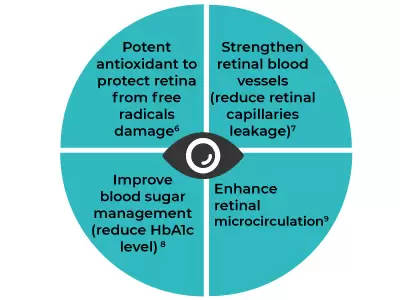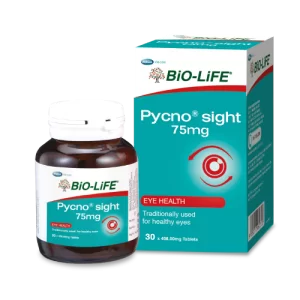
[World Diabetes Day] Diabetic complications – Diabetic Retinopathy
Oct 21, 2020
Introduction
World Diabetes Day falls on November 14th each year to raise awareness of diabetes. In Malaysia, 1 in every 5 adults are living with diabetes¹, and the prevalence of diabetes keeps on increasing every year. Therefore, it is crucial for Malaysians to know their risks and the complications of living with diabetes.
Most people are unaware that they are having diabetes until they start to develop complications.
Fortunately, eye strain is preventable, and the symptoms can be alleviated through eye health tips and natural remedies.

Ask yourself these few questions:
- When is the last time you check your blood sugar level?
- What is your recent fasting blood sugar level? And your 2-hours post-meal blood sugar level?
- Is your reading within the normal range?
- Do you have any of the signs and symptoms that suggesting you have a high blood sugar level?
Diabetes could show no symptoms at all and therefore also known as a silent disease. It is not true that diabetes only affects older adults and the elderly. Nowadays, diabetes can also affect younger generations due to factors such as unhealthy diet, sedentary lifestyle and being overweight or obese.
Complications of Diabetes
Complications of diabetes can be divided into 2 types, which is microvascular complications and macrovascular complications.

- Eye damage such as retinopathy and blindness
- Kidney damage such as kidney failure
- Nerve damage such as numbness and amputation
Macrovascular complications² (due to damage to larger blood vessels):
Cardiovascular diseases such as heart attack and strokes
What is retinopathy?
- Damage that happens in the retina of the eyes that can lead to blindness
- Retinopathy or usually known as Diabetic Retinopathy is one of the common complications that can happen among diabetic patients
- There can be no symptoms at all in the early stages or not be noticed by patients until the late stages
- Occur when the high blood sugar damages the retina blood vessels. The tiny blood vessels can leak blood and other fluids which cause the retina tissue to swell3
Vision of a normal eye and eye with Diabetic Retinopathy

Blurred vision and the presence of dark spots in the vision are common symptoms of Diabetic Retinopathy.4
It happens when new vessels were formed in order to repair or replace the damaged vessels. However, these newly formed blood vessels are abnormal and fragile. It can break and leak blood into the eye, blocking the vision.5
Am I at risk of Diabetic Retinopathy?
Risk factors of Diabetic Retinopathy includes1
- Duration of Diabetic Retinopathy (the longer, the higher risk)
- Poor control of diabetes
- Pre-existing of medical diseases such as hypertension, cardiovascular diseases, hyperlipidemia
- Obesity
- Inactive lifestyle
- Smoking
How can Pycnogenol® help?

Pycnogenol®, a natural plant extract sourced from the bark of the maritime pine that grows along the coast of southwest France. Pycnogenol® consists of highly bioavailable antioxidant called procyanidins and phenolic acids that help to protect the eyes from oxidative stress damages. Pycnogenol® has been tested in more than 1200 diabetic patients and is shown to improve the conditions of Diabetic Retinopathy. It has been clinically proven to help diabetic patients reduce the risk of and manage retinopathy and their blood sugar level.

Find out more about BiO-LiFE Pycno®sight
References
- Ministry of Health, 2017. Diabetic Retinopathy Screening. Retrieved from
- WHO, 2020. Complications of diabetes. Retrieved from https://www.who.int/diabetes/
action_online/basics/en/index3.html - Diabetes.co.uk, 2019. Diabetic Retinopathy. Retrieved from https://www.diabetes.co.uk/diabetes-complications/
diabetic-retinopathy.html#:~: text=Diabetic%20retinopathy%20
occurs%20when%20changes,the%20
surface%20of%20the%20retina - Khairallah, H., Alazzawi, L., and Sarhan, N., 2019. Mobile Smart Screening and Remote Monitoring for Vision Loss Diseases. International Journal of Engineering Research & Technology, 8(10): 1-8
- Campochiarp, P.A., 2013. Ocular Neovascularization. J Mol Med (Berl)., 91(3):311-321
- Chida, M., et al., 1999. Pycnogenol® protects the retina against oxidative damage more effectively than any other antioxidant tested. Pycnogenol® shows synergistic antioxidant effectiveness when combined with other antioxidants such as Coenzyme Q10. Ophthalmic Research, 31: 407-415
- Steigerwalt, R., et al., 2009. Pycnogenol® improves microcirculation, retinal edema, and visual acuity in early diabetic retinopathy. Journal of Ocular Pharmacology and Therapeutics, 25(6), 537-540
- Zibadi, S, Rohdewald, P, Park, D, Watson, R.R., 2008. Reduction of cardiovascular risk factors in subjects with Type 2 Diabetes by Pycnogenol® supplementation. Nutrition Research, 28: 315-320
- Spadea, L. and Balestrazzi, E. 2001. Treament of vascular retinopathies with pycnogenol. Phytotherapy Research, 15(3): 219-223



